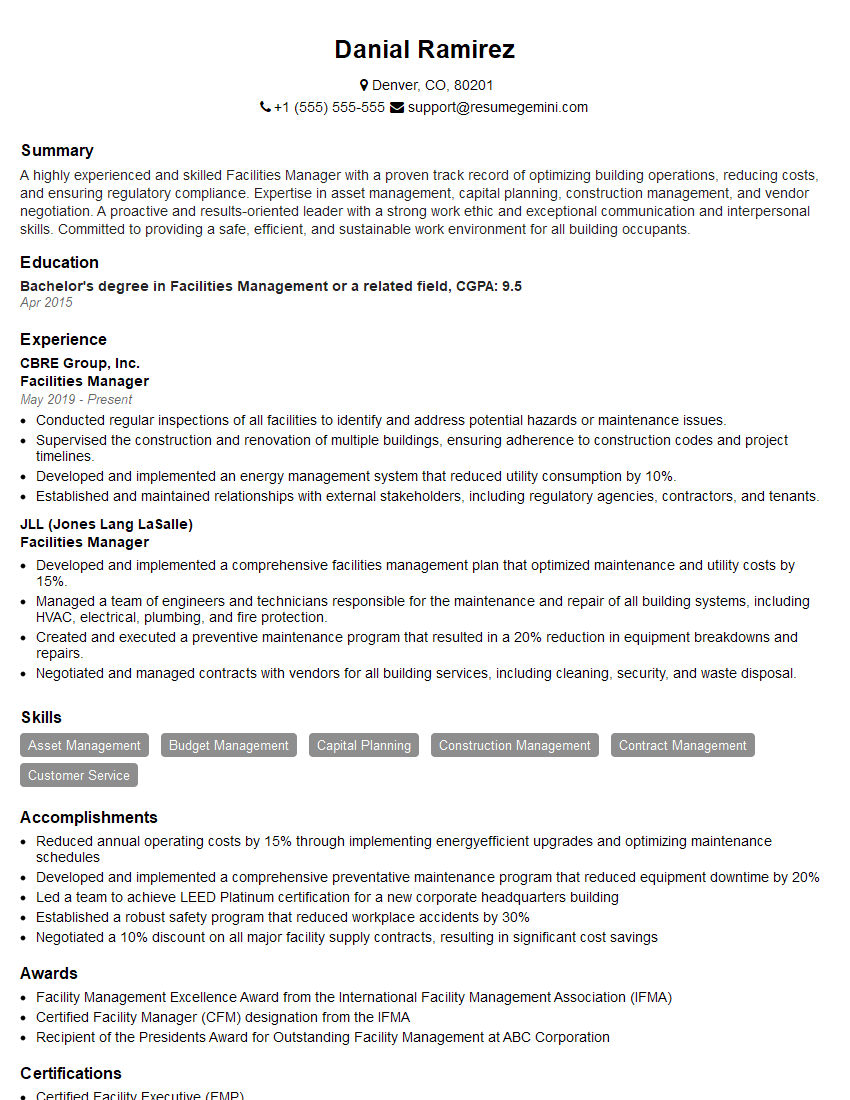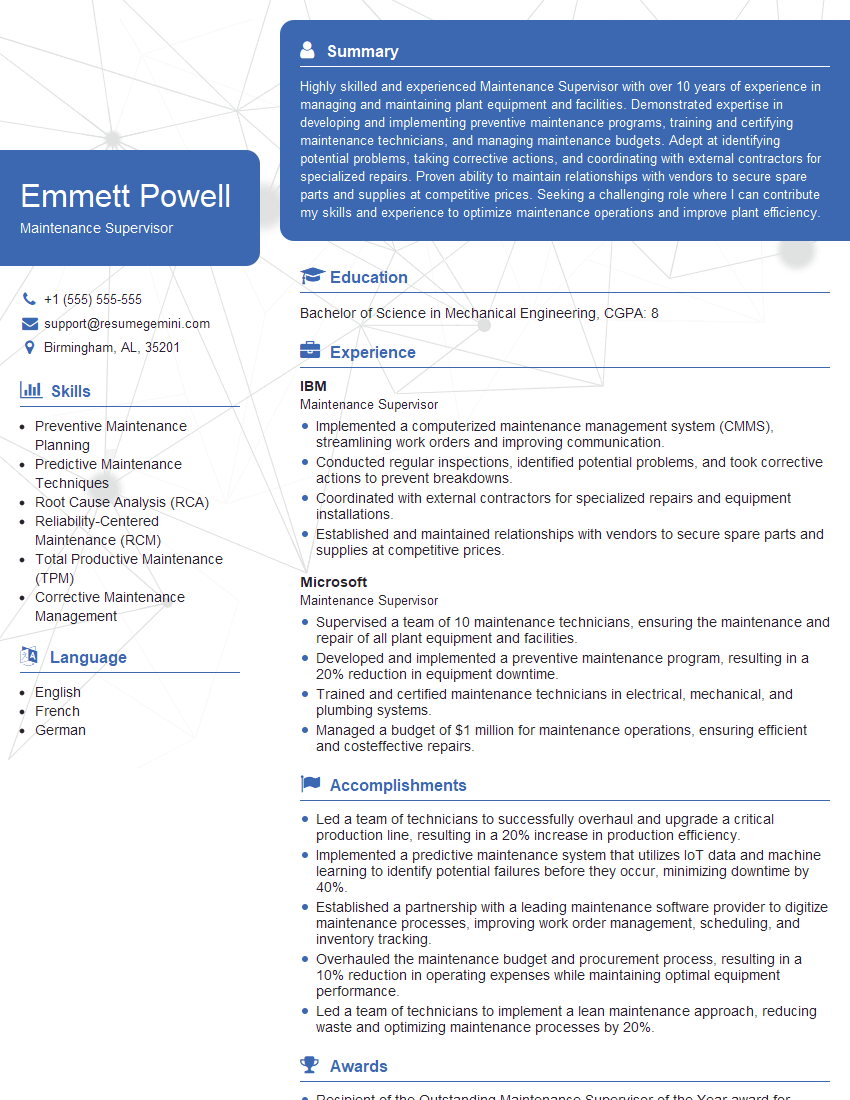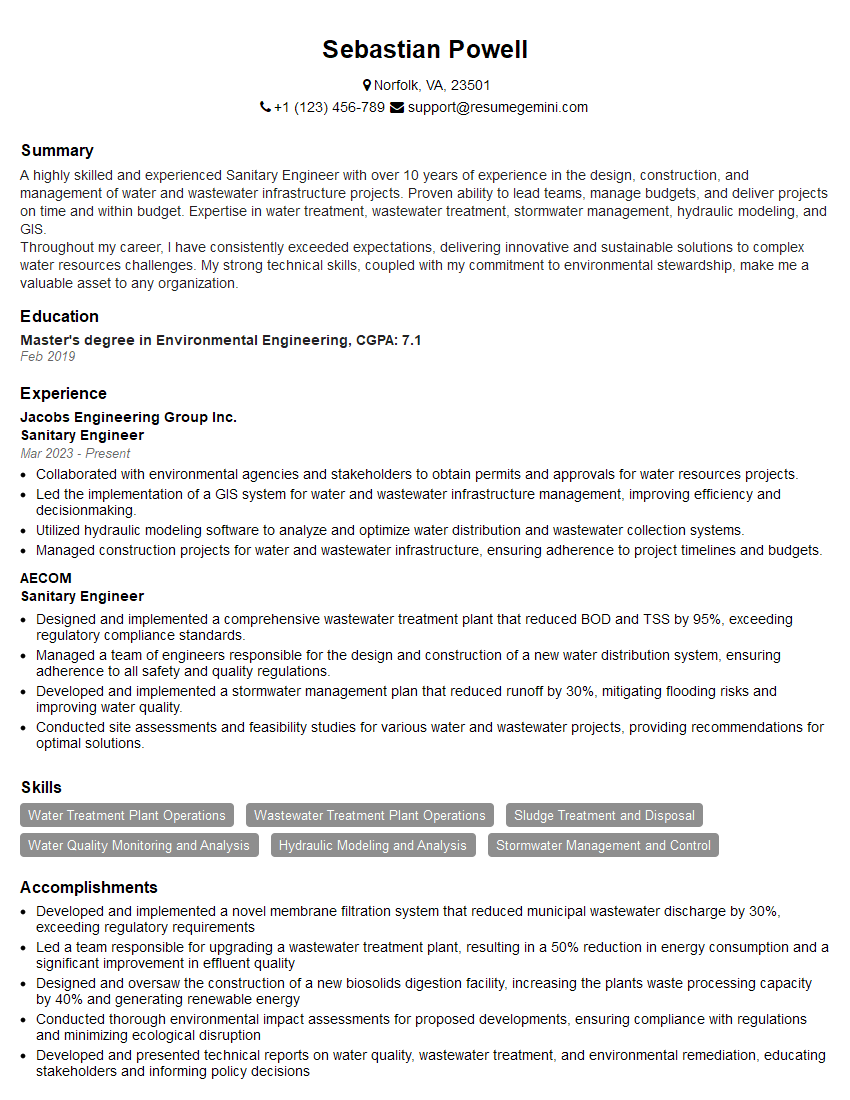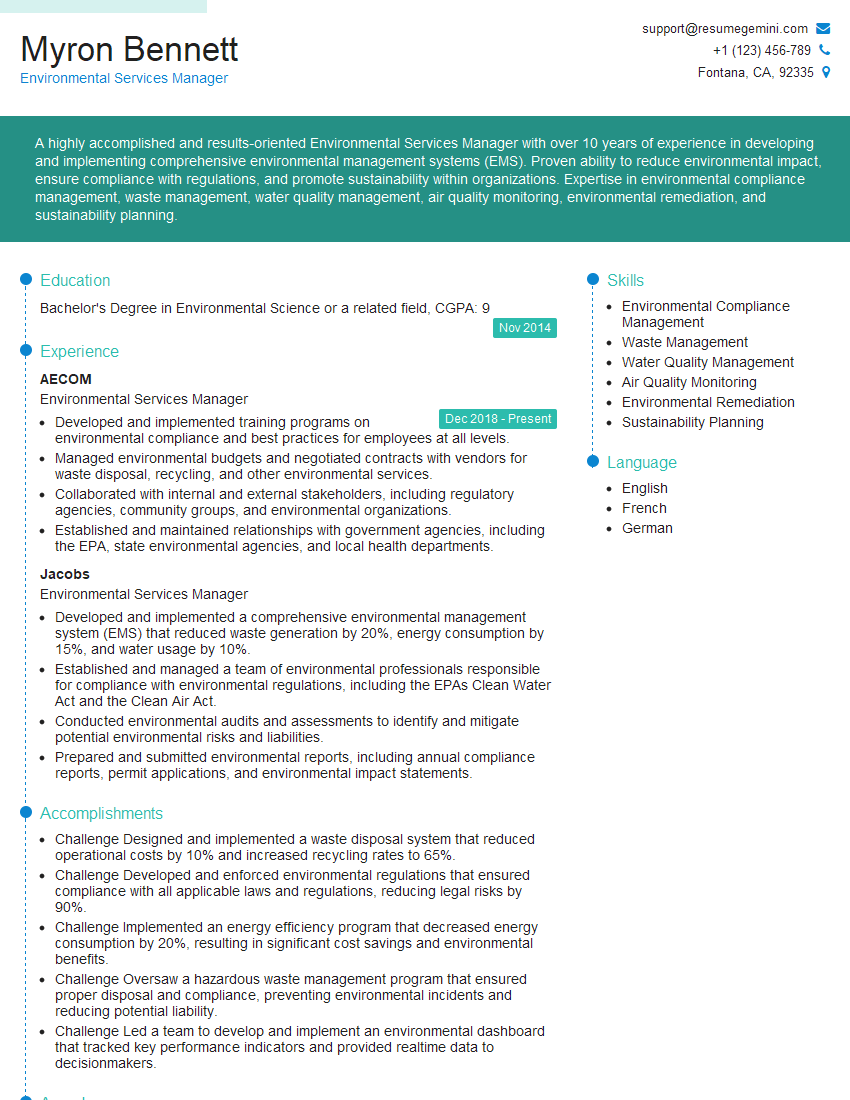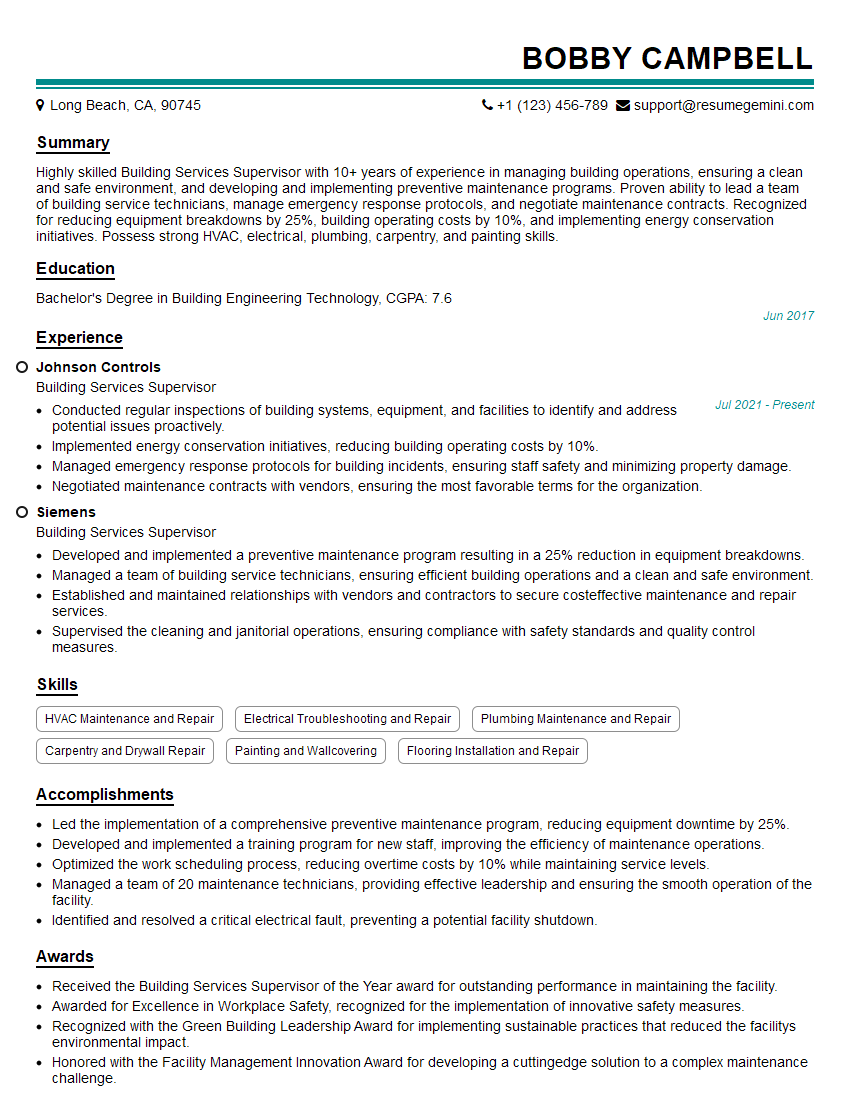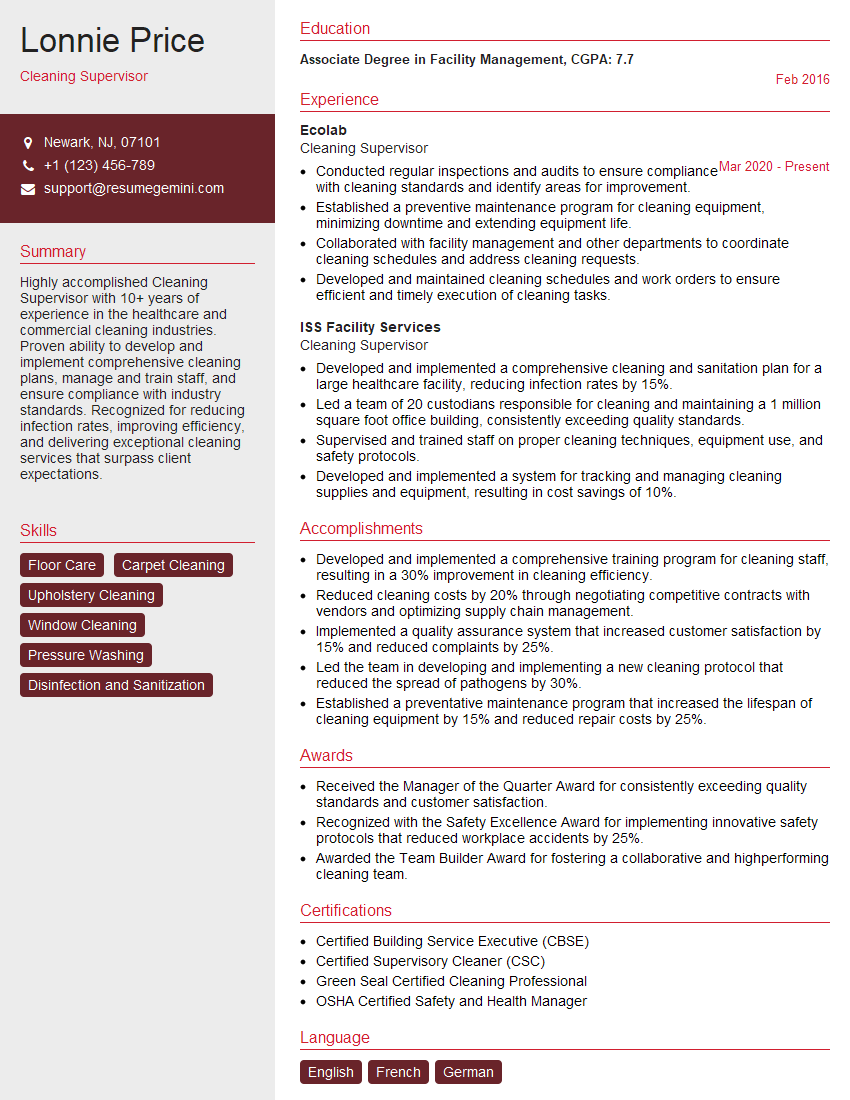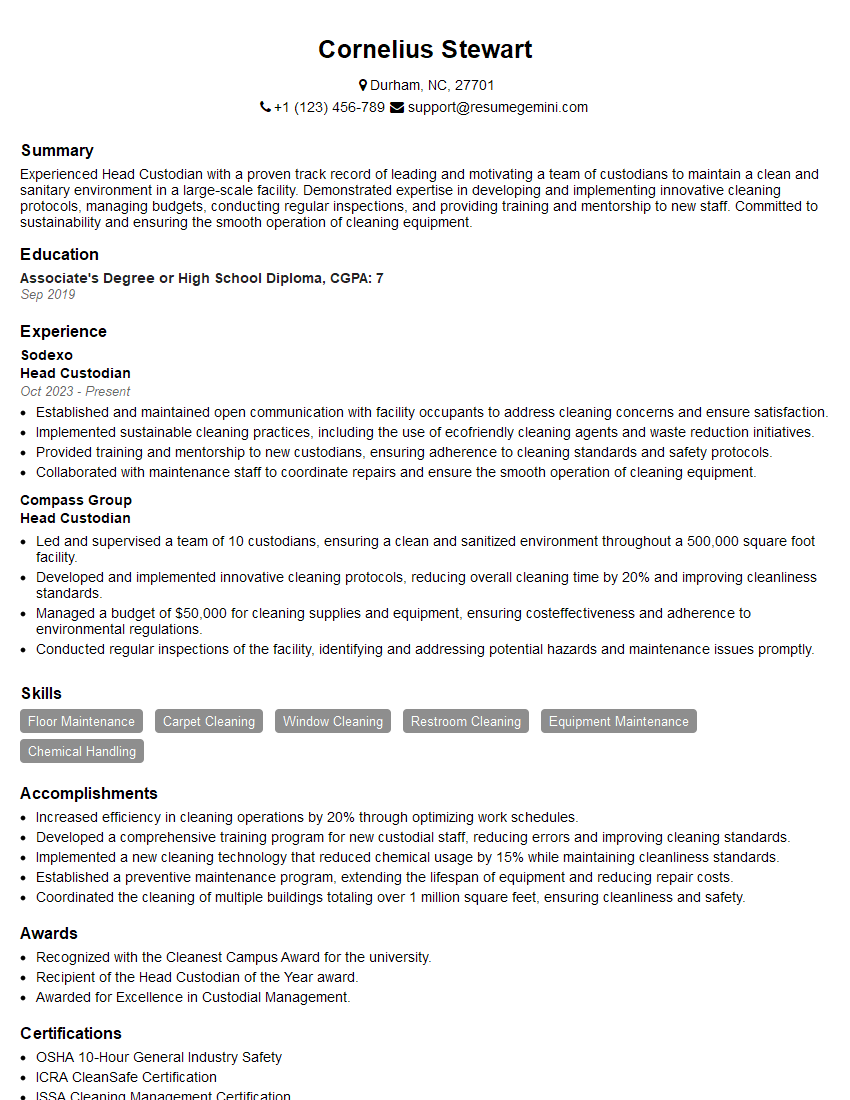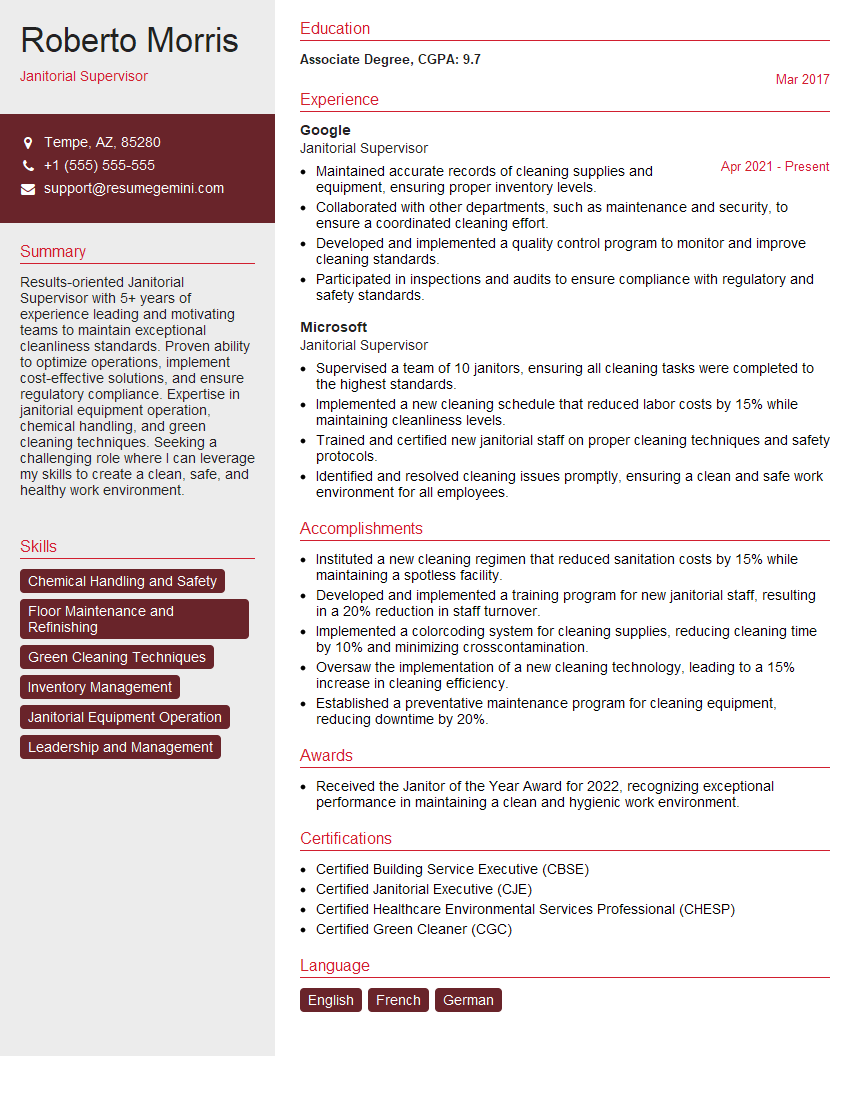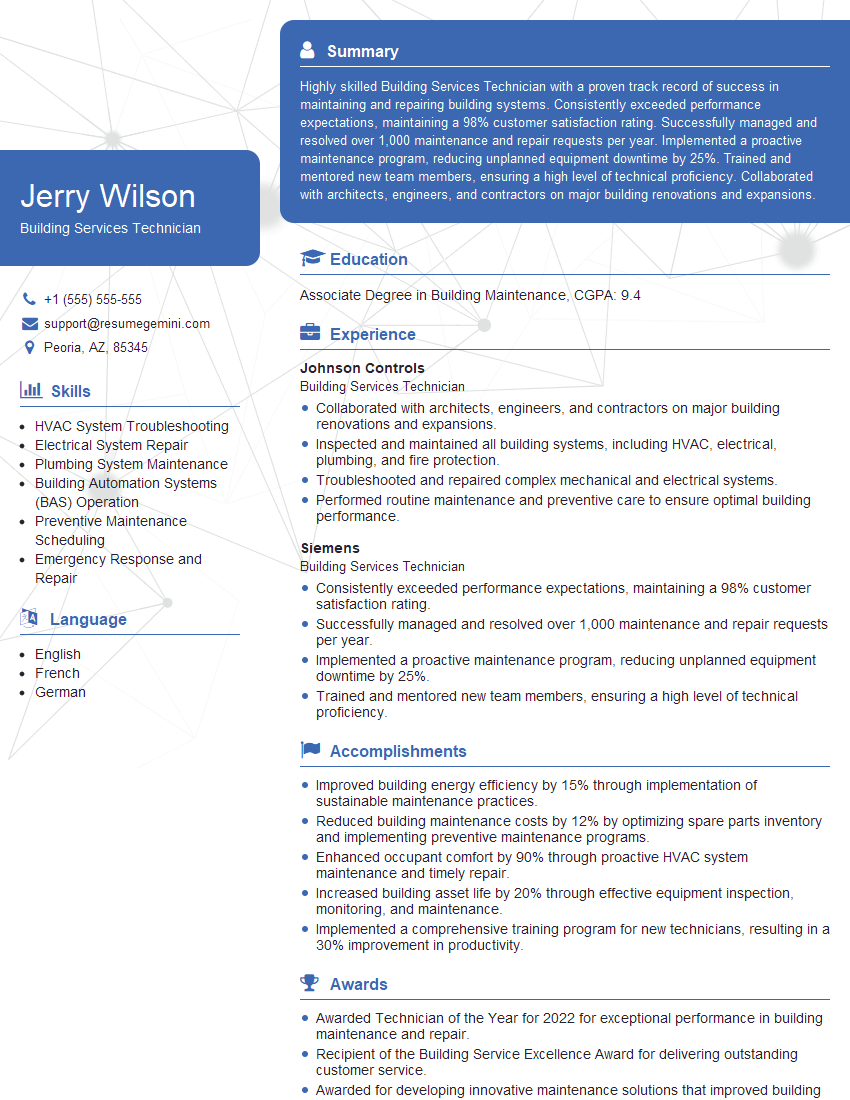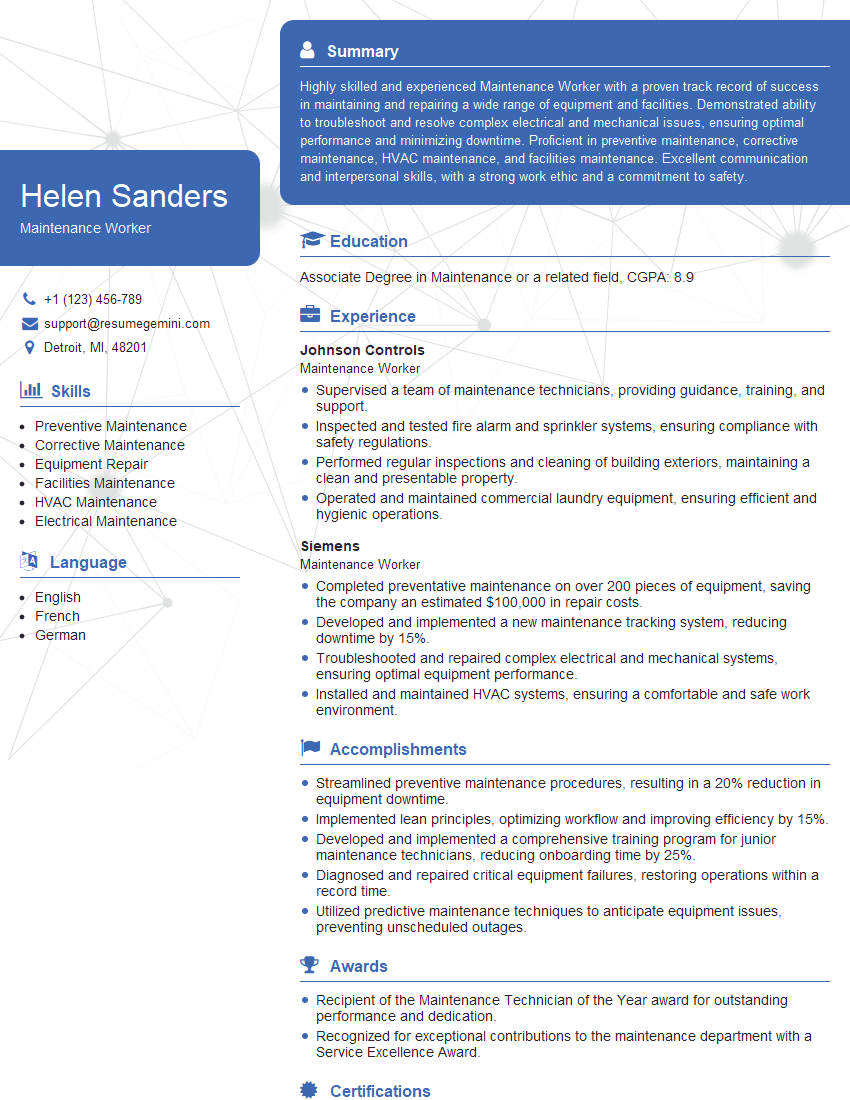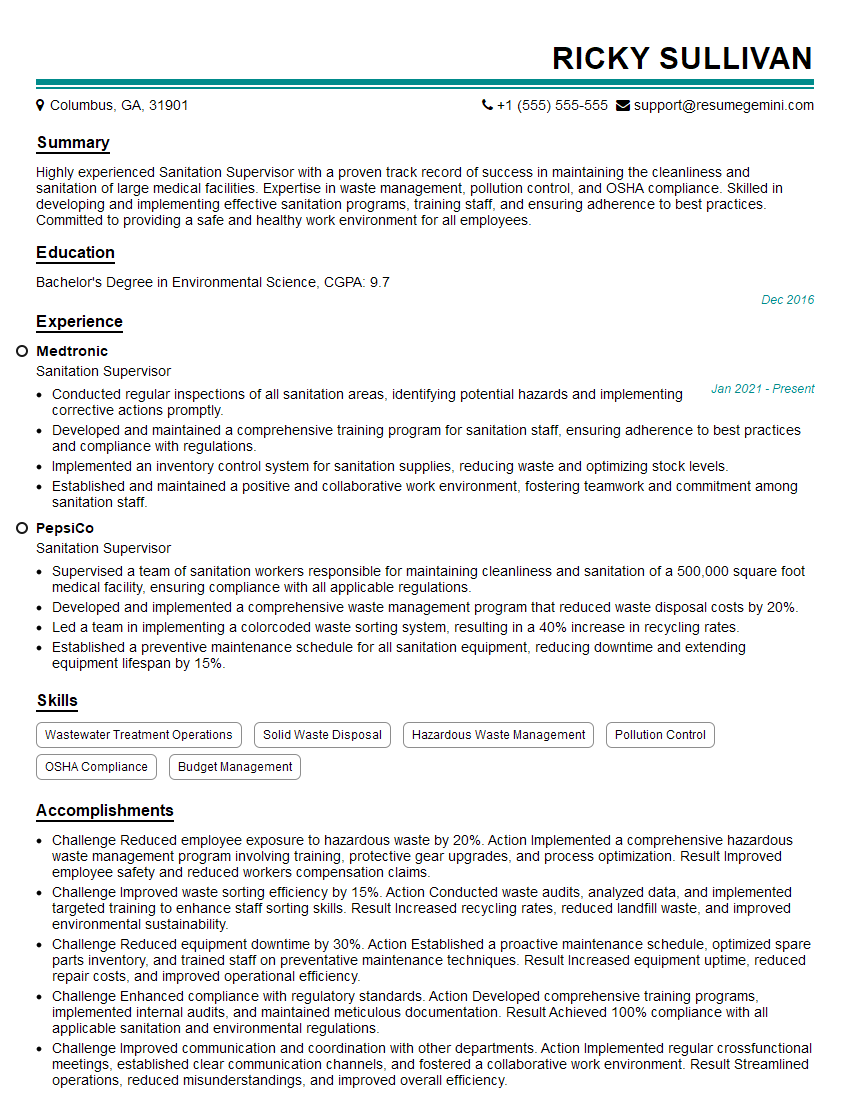Cracking a skill-specific interview, like one for Restroom Maintenance, requires understanding the nuances of the role. In this blog, we present the questions you’re most likely to encounter, along with insights into how to answer them effectively. Let’s ensure you’re ready to make a strong impression.
Questions Asked in Restroom Maintenance Interview
Q 1. Describe your experience with different types of restroom cleaning supplies and chemicals.
My experience encompasses a wide range of restroom cleaning supplies and chemicals, from everyday products to specialized solutions for tackling tough stains and biofilms. I’m familiar with various types of disinfectants, including those based on chlorine bleach, quaternary ammonium compounds (quats), and hydrogen peroxide. I understand the importance of selecting the right chemical for the specific task – for example, using a degreaser for stubborn grease buildup on floors, or a specialized toilet bowl cleaner to remove limescale and mineral deposits. I also have experience working with environmentally friendly, green cleaning products, which are increasingly important for reducing the environmental impact of restroom maintenance. I’m adept at reading and interpreting Safety Data Sheets (SDS) for all chemicals used, ensuring proper handling and storage to maintain both user and environmental safety.
- Example 1: Using a pH-neutral cleaner for general cleaning to prevent damage to surfaces like marble or granite.
- Example 2: Employing a powerful enzymatic cleaner to break down organic matter like urine stains and prevent recurring odors.
Q 2. What are the OSHA regulations concerning restroom sanitation and safety?
OSHA regulations concerning restroom sanitation and safety are crucial for maintaining a healthy and hazard-free environment. These regulations focus on preventing the spread of infectious diseases and minimizing risks associated with chemical handling and slips/falls. Key aspects include providing adequate ventilation to reduce the buildup of harmful fumes from cleaning chemicals, ensuring proper lighting to prevent accidents, and providing readily accessible personal protective equipment (PPE) like gloves, goggles, and aprons. Regular inspections are also critical for identifying and addressing hazards promptly. The specific requirements can vary depending on the size and type of facility, but the overarching goal is to create a clean, safe, and compliant restroom environment. Failure to comply with these regulations can result in significant fines and legal repercussions.
- Example: Proper disposal of hazardous cleaning chemicals according to OSHA guidelines and local regulations.
Q 3. How do you identify and address potential restroom hazards, such as spills or clogged drains?
Identifying and addressing potential restroom hazards requires a proactive and observant approach. Regular inspections are key – I look for spills (cleaning solutions, water), clogged drains (leading to potential flooding), broken fixtures (toilets, faucets, soap dispensers), and damaged floor surfaces (creating trip hazards). My process involves immediate action for urgent hazards (e.g., cleaning up a spill immediately to prevent slips), while documenting less immediate issues for repair or replacement. I use appropriate PPE (Personal Protective Equipment) when dealing with hazardous materials. For example, I would use absorbent materials to clean up a chemical spill, ensuring proper disposal afterwards. I would report a clogged drain to the appropriate maintenance team, explaining the urgency and potential consequences. Proactive preventative maintenance, such as regular drain cleaning, minimizes the occurrence of these hazards.
- Example: Immediately placing caution tape around a wet floor after a spill.
- Example: Reporting a leaking faucet to prevent water damage and conserve resources.
Q 4. Explain your process for cleaning and disinfecting toilets, sinks, and floors.
My cleaning and disinfecting process follows a consistent and effective protocol. I begin by thoroughly pre-cleaning the surfaces to remove loose debris. For toilets, this involves scrubbing the bowl and exterior with a toilet bowl cleaner, paying close attention to areas where grime accumulates. I then disinfect all surfaces using an appropriate disinfectant solution, following the manufacturer’s instructions regarding contact time for optimal effectiveness. Sinks are cleaned and disinfected similarly, including faucets and handles. Floors are swept or vacuumed, followed by mopping with a disinfectant solution. After cleaning, I replenish soap, paper towels, and toilet paper as needed. I always ensure proper ventilation during cleaning to minimize exposure to cleaning chemicals.
- Example: Using a dedicated cleaning brush and sponge for each area (toilet, sink, floor) to avoid cross-contamination.
Q 5. How do you maintain restroom hygiene standards in high-traffic areas?
Maintaining restroom hygiene standards in high-traffic areas requires a more frequent and intensified cleaning schedule. This could involve multiple cleanings per day, focusing on high-touch surfaces like door handles, faucets, and soap dispensers. Strategic placement of hand sanitizer dispensers can further enhance hygiene. Regular checks for supplies and prompt restocking are crucial. A well-maintained restroom encourages responsible usage and minimizes the accumulation of waste. In some instances, utilizing automated cleaning systems, like automatic floor scrubbers, may be beneficial in high-traffic environments.
- Example: Implementing a ‘spot cleaning’ system, whereby high-touch areas are cleaned and disinfected at regular intervals throughout the day.
Q 6. What is your experience with preventative maintenance in restrooms?
Preventative maintenance is crucial for minimizing costly repairs and ensuring long-term functionality. This includes regular inspections for leaks, clogs, and damage to fixtures; ensuring proper ventilation to prevent mold and mildew; and implementing a schedule for routine maintenance tasks such as toilet flapper replacement and faucet repairs. Preventative measures significantly reduce the risk of major problems and contribute to a more sanitary restroom environment. By regularly checking for and addressing minor issues before they escalate, we save time, resources, and potential health hazards.
- Example: Regularly lubricating door hinges to prevent squeaking and ensure smooth operation.
Q 7. How do you handle restroom repairs and maintenance requests?
Handling restroom repairs and maintenance requests involves efficient communication and problem-solving. I typically start by assessing the nature of the problem; minor issues, like a clogged toilet, might be handled directly, while more complex problems, such as a broken water pipe, require notifying the facilities management team. For each request, I clearly document the issue, its urgency, and any steps taken to address it. Accurate documentation ensures accountability and facilitates efficient repairs. I strive to resolve issues promptly and effectively, minimizing disruption to restroom users.
- Example: Using a plunger to unclog a toilet, then documenting the incident and the resolution.
- Example: Submitting a work order for a more complex repair, including photos and a detailed description of the issue.
Q 8. Describe your experience with restocking restroom supplies.
Restocking restroom supplies is a crucial aspect of maintaining a clean and functional restroom. It involves more than just filling dispensers; it’s about anticipating needs and ensuring consistent availability. My approach involves a systematic checklist, starting with a visual inspection. I check dispenser levels for toilet paper, paper towels, soap, and hand sanitizer, noting how much remains and projecting usage based on traffic patterns. For example, during peak hours at a busy event venue, consumption increases dramatically, so I’ll make more frequent restocking runs. I also inspect for damaged or low-quality supplies and replace them immediately, ensuring all supplies meet standards for hygiene and quality. This proactive approach minimizes interruptions and ensures a positive user experience.
- Visual Inspection: Regularly checking dispenser levels and supply quality.
- Demand Forecasting: Anticipating needs based on time of day, day of week, and event schedules.
- Quality Control: Ensuring all supplies meet hygiene and quality standards.
- Inventory Management: Tracking supply levels to avoid running out.
Q 9. How do you manage waste disposal in restrooms?
Efficient waste disposal is paramount for hygiene and odor control. My method involves regular and frequent emptying of waste receptacles, focusing on both trash cans and sanitary disposal units. I use appropriate personal protective equipment (PPE), such as gloves, and follow strict procedures for handling waste to prevent cross-contamination. Proper bagging, sealing, and transport to designated disposal areas are essential. In high-traffic areas, I may schedule more frequent waste collection to prevent overflow. Regular cleaning and sanitization of the waste receptacles themselves are crucial, preventing bacterial buildup and unpleasant odors. For example, in a restaurant setting, I’d empty and clean the trash cans more often during peak lunch and dinner hours.
- PPE Usage: Always wearing gloves and other appropriate safety equipment.
- Frequent Emptying: Regular emptying of waste receptacles, especially in high-traffic areas.
- Proper Bagging and Sealing: Ensuring waste is properly contained.
- Sanitization: Regularly cleaning and sanitizing waste receptacles.
Q 10. What are the best practices for controlling odors in restrooms?
Odor control is vital for creating a pleasant restroom experience. My strategy employs a multi-pronged approach: First, diligent cleaning and waste disposal minimize the source of odors. Second, air fresheners are strategically placed, but I avoid overpowering scents that could trigger allergies or sensitivities; opting for subtle, pleasant fragrances. Third, regular ventilation is critical. This can involve ensuring exhaust fans are functional and properly sized for the space. In cases of persistent, strong odors, a deep cleaning might be necessary, possibly involving the use of specialized odor-neutralizing solutions. I always try to identify and address the source of the odor, rather than just masking it with air fresheners.
- Regular Cleaning: Frequent cleaning and waste disposal to eliminate odor sources.
- Strategic Air Freshening: Use of subtle, pleasant-smelling air fresheners.
- Ventilation: Ensuring exhaust fans are functioning properly.
- Odor Neutralization: Employing specialized solutions for persistent odors.
Q 11. How do you ensure the proper functioning of restroom plumbing fixtures?
Maintaining functional plumbing is critical. My routine includes regular checks for leaks, drips, and clogs. I listen for unusual sounds from pipes and toilets. For toilets, I check for proper flushing, water level, and leaks around the base. For sinks and faucets, I check for proper water pressure, leaks, and efficient operation. I’m proficient in basic plumbing repairs, such as unclogging drains using plungers or augers. For more complex issues, I immediately report the problem to the appropriate maintenance personnel. Regular preventative maintenance, such as cleaning aerators and checking for mineral buildup, prevents more serious problems. Thinking proactively about potential issues and addressing them before they become major problems saves time and money.
- Regular Inspections: Frequent checks for leaks, drips, and clogs.
- Basic Plumbing Repair: Proficiency in unclogging drains and addressing minor plumbing issues.
- Preventative Maintenance: Regular cleaning and inspection to prevent larger problems.
- Reporting: Prompt reporting of complex issues to specialized personnel.
Q 12. Describe your experience with troubleshooting common restroom problems.
Troubleshooting is a key part of my role. Common problems include clogged toilets, leaky faucets, and jammed soap dispensers. I systematically approach troubleshooting: I first identify the problem by observing the symptoms. Then, I attempt to isolate the cause, checking for simple fixes, such as a clogged drain or low water pressure. I utilize various tools, including plungers, augers, and wrenches, to address minor plumbing and mechanical issues. If the problem persists or is beyond my skillset, I escalate the issue to the appropriate maintenance team, providing a detailed description of the problem and observed symptoms. For example, a running toilet may be due to a faulty flapper, requiring replacement. A thorough understanding of restroom systems allows for quick identification and resolution of many common problems.
- Problem Identification: Observing symptoms and isolating the cause.
- Basic Repair: Using tools and knowledge to address minor issues.
- Escalation: Reporting complex problems to skilled maintenance personnel.
- Documentation: Recording problem details for efficient resolution and tracking.
Q 13. What are your strategies for optimizing restroom cleaning efficiency?
Optimizing cleaning efficiency involves strategic planning and efficient methods. I utilize a systematic approach, cleaning from top to bottom and following a set routine. This minimizes wasted time and effort, ensuring a consistent level of cleanliness. I use appropriate cleaning solutions and tools, based on the surface and type of soil. Pre-treating stubborn stains before cleaning saves time in the long run. I also prioritize using microfiber cloths and mops, as they are more absorbent and reduce the need for excessive cleaning solution. Additionally, teamwork and clear communication within the cleaning team are crucial for efficient coverage and coordination.
- Systematic Approach: Following a set cleaning routine, from top to bottom.
- Appropriate Tools: Using correct cleaning solutions and equipment for various surfaces.
- Pre-Treatment: Addressing stubborn stains before general cleaning.
- Efficient Tools: Utilizing microfiber cloths and mops.
- Teamwork: Coordinating cleaning efforts with colleagues.
Q 14. How do you maintain a clean and organized restroom supply closet?
Maintaining an organized supply closet is essential for efficient restocking. My strategy involves a well-defined storage system using labeled shelves, bins, and containers. Supplies are organized by type and frequency of use, with frequently used items readily accessible. I utilize a first-in, first-out (FIFO) system to prevent expiration and waste. Regular inventory checks help to identify low stock levels and prevent unexpected shortages. A clean and organized closet prevents clutter and simplifies the restocking process, making the entire maintenance operation smoother and more efficient. This is particularly important for larger facilities with multiple restrooms.
- Labeled Storage: Using clear labels for easy identification of supplies.
- Organized Shelving: Arranging supplies by type and frequency of use.
- FIFO System: Implementing a first-in, first-out inventory system.
- Inventory Checks: Regular checks to ensure adequate stock levels.
- Cleanliness: Maintaining a clean and organized space.
Q 15. How do you handle situations involving restroom vandalism or damage?
Handling restroom vandalism requires a multi-pronged approach. First, safety is paramount. I would immediately secure the area, ensuring no one is injured and preventing further damage. Then, I’d thoroughly document the incident – taking detailed photos and noting the extent of the damage, the time of discovery, and any potential witnesses. This documentation is crucial for insurance claims and identifying patterns of vandalism. Next, I’d report the incident to the appropriate authorities, such as building management or the police, depending on the severity of the damage. Finally, I’d oversee the repairs, ensuring that the restroom is restored to its original condition as quickly and efficiently as possible. For example, if graffiti is involved, I’d ensure a professional cleaning service specializing in graffiti removal is used, to avoid damaging the underlying surfaces. Repeated incidents might necessitate installing improved security measures, like enhanced lighting or surveillance cameras.
Career Expert Tips:
- Ace those interviews! Prepare effectively by reviewing the Top 50 Most Common Interview Questions on ResumeGemini.
- Navigate your job search with confidence! Explore a wide range of Career Tips on ResumeGemini. Learn about common challenges and recommendations to overcome them.
- Craft the perfect resume! Master the Art of Resume Writing with ResumeGemini’s guide. Showcase your unique qualifications and achievements effectively.
- Don’t miss out on holiday savings! Build your dream resume with ResumeGemini’s ATS optimized templates.
Q 16. What are your methods for monitoring and tracking restroom cleanliness?
Monitoring restroom cleanliness involves a combination of scheduled inspections and proactive response to reports. I use a checklist system, inspecting restrooms at set intervals throughout the day – for instance, every two hours during peak usage. This checklist covers key areas: floor cleanliness, toilet and sink hygiene, soap and paper towel levels, and the overall condition of the facilities. Each inspection is documented, with any issues noted and assigned a priority level. We also implement a system for staff and users to report issues – for example, a dedicated email address or an app that allows users to submit photos and descriptions of cleanliness problems. This allows us to address issues quickly, preventing small problems from escalating. Data analysis of these inspections helps us identify trends – for example, if a particular restroom consistently shows higher levels of soilage, it may indicate a need for more frequent cleaning or additional staff during certain hours.
Q 17. How do you prioritize tasks when handling multiple restroom cleaning requests?
Prioritizing restroom cleaning requests involves a triage system based on urgency and impact. Requests are categorized by urgency – immediate (e.g., overflowing toilet, major spill), high (e.g., significant mess, lack of supplies), medium (e.g., minor spills, low soap), and low (e.g., routine cleaning). The immediate and high-priority requests are addressed immediately, while the medium and low-priority requests are scheduled based on available staff and resource constraints. Consider factors such as location (higher-traffic areas prioritized) and potential health hazards (a biohazard cleanup would obviously take precedence). Imagine a scenario where one restroom has a clogged toilet and another has low paper towels. The clogged toilet represents an immediate health hazard and needs to be addressed first, while the low paper towels can be handled later.
Q 18. Describe your experience working with different types of restroom fixtures.
My experience encompasses a wide variety of restroom fixtures, from standard toilets and sinks to more advanced, water-efficient models. I am familiar with different types of faucets (sensor, lever, push-button), toilet types (low-flow, dual-flush), and hand dryers (high-speed, jet air, etc.). I understand the maintenance needs of each type. For example, sensor faucets require periodic calibration, while low-flow toilets might need occasional descaling to prevent clogs. Knowing the specifics of each fixture ensures proper cleaning and maintenance, preventing costly repairs and ensuring optimal functionality. I also have experience working with accessible restroom fixtures, ensuring compliance with ADA regulations.
Q 19. How do you ensure the safety of restroom cleaning personnel?
Ensuring the safety of restroom cleaning personnel is a top priority. This begins with providing appropriate Personal Protective Equipment (PPE), including gloves, eye protection, and protective clothing, to prevent exposure to hazardous materials like cleaning chemicals and biohazards. Regular training sessions cover safe handling of chemicals, proper use of equipment, and emergency procedures. We emphasize the importance of following safety protocols, such as proper ventilation when using strong cleaning agents, reporting any injuries or equipment malfunctions immediately and using ergonomic practices to avoid musculoskeletal injuries during tasks like lifting heavy supplies. Additionally, we provide clear guidelines on handling situations such as needles or other potentially dangerous objects found in restrooms. A safe working environment is key to both efficiency and retention of qualified staff.
Q 20. What are the different types of disinfectants and their effective applications?
Different disinfectants have different strengths and applications. Common disinfectants include quaternary ammonium compounds (quats), bleach solutions, and alcohol-based disinfectants. Quats are effective against a broad range of bacteria and viruses and are commonly used for general surface disinfection. Bleach solutions are powerful disinfectants effective against many pathogens but can be corrosive and require proper dilution. Alcohol-based disinfectants are effective against some bacteria and viruses but are less effective against spores. The choice of disinfectant depends on the specific need. For example, bleach is effective for removing bloodborne pathogens, while quats are suitable for regular cleaning of toilet seats and sinks. Always follow manufacturer’s instructions regarding dilution and contact time for effective disinfection.
Q 21. How familiar are you with various cleaning equipment (e.g., floor scrubbers, vacuum cleaners)?
I am proficient in operating and maintaining a variety of cleaning equipment. This includes automatic floor scrubbers, which significantly increase cleaning efficiency and reduce the physical strain on staff. I understand the importance of proper maintenance, including regular cleaning and changing of brushes and solutions. I also have experience with various types of vacuum cleaners, including wet-dry vacuums, suitable for cleaning up spills and other messes. Other equipment I’m familiar with includes pressure washers for deep cleaning of heavily soiled areas, and specialized equipment for removing graffiti or other stubborn stains. Knowing how to use and maintain these tools effectively is essential for maintaining restroom cleanliness and efficiency.
Q 22. How would you address a customer complaint about restroom cleanliness?
Addressing a customer complaint about restroom cleanliness begins with empathy and immediate action. I would first apologize sincerely for the inconvenience and assure the customer that their feedback is valuable. Then, I’d quickly assess the situation. Is it a one-time issue, or a recurring problem? A simple oversight like a missed spot can be rectified on the spot; I’d clean the area immediately and offer a small token of apology, such as a coupon for a discount or a free beverage if applicable. For more systemic problems, such as consistently dirty floors or broken fixtures, I’d document the complaint, take photos if necessary, and report it to my supervisor immediately. I’d then follow up with the customer within a set timeframe to confirm the issue is resolved and assure them it won’t happen again. This process ensures both immediate resolution and long-term preventative measures are implemented.
For example, if a customer complained about a clogged toilet, I’d immediately attend to it, ensuring the proper cleaning and preventative measures, then report this issue to maintenance for potential longer-term fixes such as checking the plumbing.
Q 23. What is your experience with restroom air quality control?
Restroom air quality is crucial for a positive user experience. My experience encompasses implementing and maintaining strategies to ensure optimal air quality. This includes regular inspection and cleaning of ventilation systems, ensuring proper airflow and preventing the buildup of odors and moisture. I’m proficient in identifying and addressing issues such as malfunctioning exhaust fans or blocked vents. I understand the importance of using appropriate cleaning agents that don’t contribute to poor air quality. Additionally, I’m familiar with different ventilation technologies and can advise on upgrading systems for improved efficacy. For instance, I’ve successfully implemented a system using air purifiers with HEPA filters in high-traffic restrooms to reduce airborne contaminants and odors. This dramatically improved user satisfaction and reduced complaints.
Q 24. How do you handle emergency situations in the restroom, like a medical emergency?
Handling emergency situations requires quick thinking and decisive action. My training includes first aid and CPR certification. In the event of a medical emergency, my first priority is to assess the situation and ensure the safety of the person involved and others in the restroom. I’d immediately call for emergency medical services (EMS) and provide basic first aid until they arrive, following the guidelines of my training. Simultaneously, I’d clear the restroom of other patrons to allow for easy access by EMS personnel. I’d also ensure the restroom is kept secure until authorities arrive and have completed their duties. I would then thoroughly document the incident for reporting purposes and follow up with my supervisor to review the situation and discuss any potential preventative measures that can be implemented to minimize the risk of future incidents.
Q 25. Describe your knowledge of different restroom designs and their maintenance needs.
My knowledge of restroom designs encompasses various styles, from traditional to modern, and their corresponding maintenance needs. I understand that different designs present unique challenges. For instance, a restroom with a high number of fixtures demands more frequent cleaning and maintenance. A restroom with specialized materials, like polished stone, might require specific cleaning agents to avoid damage. Similarly, accessible restrooms need extra attention to ensure compliance with ADA standards, such as maintaining clear access pathways and the functionality of grab bars. I can tailor my cleaning and maintenance procedures to any restroom design, ensuring efficiency and effectiveness. I’ve worked with various designs, from simple single-user restrooms to large multi-stall facilities with specialized fixtures, adapting my approach to the unique needs of each.
Q 26. Explain your understanding of the importance of proper ventilation in restrooms.
Proper ventilation is paramount in restroom maintenance. It prevents the buildup of moisture, which can lead to mold and mildew growth, and it controls odors, ensuring a pleasant environment for users. Without adequate ventilation, humidity levels rise, increasing the risk of slipping hazards from wet floors and facilitating the spread of bacteria and viruses. The exhaust fans need regular inspection and cleaning to ensure they operate at maximum efficiency. Insufficient ventilation can also damage building materials over time due to the accumulation of moisture. Think of it like this: your lungs need fresh air to function properly; restrooms need ventilation to maintain hygiene and prevent damage.
Q 27. How do you ensure compliance with local health codes and regulations?
Ensuring compliance with local health codes and regulations is a crucial part of my responsibilities. I’m familiar with the specific regulations in my area, covering aspects such as hygiene standards, waste disposal, and the use of approved cleaning products. I adhere to strict protocols for handwashing, sanitization, and waste management. I maintain detailed records of all cleaning and maintenance activities, ensuring traceability for inspection purposes. I actively participate in training sessions to stay updated on changes in regulations and best practices. Non-compliance can lead to serious penalties, so maintaining a diligent approach to regulations is non-negotiable.
Q 28. What are your strategies for maintaining a positive and professional attitude while performing restroom cleaning tasks?
Maintaining a positive and professional attitude while cleaning restrooms is essential. I approach my work with a sense of pride and professionalism, understanding that restroom cleanliness is directly linked to the overall impression of a facility. I always maintain a neat and clean appearance, wear the appropriate PPE, and engage respectfully with anyone I encounter. I view my work as a service, aiming to provide a pleasant and hygienic experience for every user. I proactively address issues before they escalate, anticipating needs and maintaining a proactive rather than reactive approach. Remember, even a simple smile and a friendly greeting can make a big difference in the perception of a clean restroom. It’s about creating a welcoming environment, not just a clean one.
Key Topics to Learn for Restroom Maintenance Interview
- Cleaning and Sanitization: Understanding proper cleaning techniques for various restroom surfaces (toilets, sinks, floors, etc.), including the selection and use of appropriate cleaning agents and disinfectants. Practical application: Demonstrating knowledge of EPA-registered disinfectants and their effective application.
- Preventive Maintenance: Identifying and addressing potential issues before they become major problems. This includes regular inspections, minor repairs (e.g., fixing leaky faucets, unclogging drains), and scheduling necessary repairs. Practical application: Describing a proactive maintenance schedule and its benefits in preventing costly repairs and ensuring restroom functionality.
- Troubleshooting and Repair: Diagnosing and resolving common restroom problems such as plumbing issues, electrical malfunctions, and fixture repairs. Practical application: Explaining your approach to troubleshooting a clogged toilet or a malfunctioning hand dryer.
- Safety and Hygiene: Adhering to safety regulations and best practices for handling cleaning chemicals, maintaining a safe working environment, and preventing the spread of germs. Practical application: Describing your understanding of OSHA guidelines and safe handling procedures for cleaning solutions.
- Inventory Management: Maintaining adequate supplies of cleaning products, toilet paper, soap, and other necessary items. Practical application: Explaining your approach to tracking inventory and reordering supplies efficiently.
- Customer Service: Understanding the importance of maintaining a clean and pleasant restroom environment for users. Practical application: Describing how you would handle a complaint or a negative restroom experience.
- Waste Management: Proper disposal of waste, including sanitary waste and recycling. Practical application: Explaining your knowledge of local waste disposal regulations and best practices for waste separation.
Next Steps
Mastering restroom maintenance is crucial for a successful and rewarding career. It’s a skillset in high demand, offering opportunities for growth and advancement within facilities management. To maximize your job prospects, creating a strong, ATS-friendly resume is essential. ResumeGemini is a trusted resource that can help you build a professional and impactful resume tailored to highlight your skills and experience. Examples of resumes specifically designed for restroom maintenance positions are available through ResumeGemini, providing you with templates and guidance to showcase your abilities effectively.
Explore more articles
Users Rating of Our Blogs
Share Your Experience
We value your feedback! Please rate our content and share your thoughts (optional).
What Readers Say About Our Blog
Hi, I have something for you and recorded a quick Loom video to show the kind of value I can bring to you.
Even if we don’t work together, I’m confident you’ll take away something valuable and learn a few new ideas.
Here’s the link: https://bit.ly/loom-video-daniel
Would love your thoughts after watching!
– Daniel
This was kind of a unique content I found around the specialized skills. Very helpful questions and good detailed answers.
Very Helpful blog, thank you Interviewgemini team.
